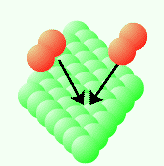Fundamentals of Density-Functional Theory
 Density-functional theory (DFT) offers a
powerful and elegant method for calculating the ground-state total energy and electron
density of a system of interacting electrons. The system may range in complexity from a
single atom to a complex system such as gas molecules together with the atoms of the
solid surface on which they are about to be adsorbed and where they will react with one
another, guided by the total energy (illustrated here). The whole theory is based on
functionals of the electron density, which therefore plays the central role. However,
the key functional, which describes the total energy of the electrons as a functional
of their density, is not known exactly: the part of it which describes electronic
exchange and correlation has to be approximated in practical calculations.
Density-functional theory (DFT) offers a
powerful and elegant method for calculating the ground-state total energy and electron
density of a system of interacting electrons. The system may range in complexity from a
single atom to a complex system such as gas molecules together with the atoms of the
solid surface on which they are about to be adsorbed and where they will react with one
another, guided by the total energy (illustrated here). The whole theory is based on
functionals of the electron density, which therefore plays the central role. However,
the key functional, which describes the total energy of the electrons as a functional
of their density, is not known exactly: the part of it which describes electronic
exchange and correlation has to be approximated in practical calculations.
I have a long-standing interest in those aspects of the exact functionals that are
not reflected in the commonly used approximations. In 1986, Michael
Schlüter, Lu Sham and I [1] calculated an accurate exchange-correlation
potential for silicon using many-body perturbation theory, and we showed that the
"band-gap problem" (the observation that the electronic band gap of semiconductors in
density-functional-theory calculations was only about 50% of the experimental band gap)
was present even with our more accurate exchange-correlation potential, and therefore
corresponded to a non-analyticity in the functional, rather than an inadequacy of the
local-density approximation normally used in density-functional theory.
Later studies included an investigation of exact DFT for a model semiconducting wire
using Monte Carlo methods [2], and a study of exact DFT in the presence of a
macroscopic electric field [3] (which for an infinite solid requires DFT to be
augmented to become a density-polarisation functional theory).
Our iDEA code [4] combines exact solution of the many-electron Schrödinger equation with powerful reverse-engineering techniques to provide insight into numerous aspects of DFT functionals [5], and novel functional approximations [6].
Much of our recent work on the fundamentals of DFT is concerned with the
important challenges of time-dependent DFT, and is described on the
page on Quantum Dynamics of Interacting Electrons.
1. "Accurate exchange-correlation potential for silicon and its discontinuity on
addition of an electron", R.W. Godby, M. Schlüter and L.J. Sham,
Phys. Rev. Lett. 56 2415 (1986). Abstract
2. "Investigating exact density-functional theory of a model semiconductor", W.
Knorr and R.W. Godby, Phys. Rev. Lett. 68 639 (1992).
Abstract
3. "Density-polarisation functional theory of the response of a periodic insulating
solid to an electric field", X. Gonze, P. Ghosez and R.W. Godby, Phys. Rev. Lett.
74 4035 (1995). Abstract
4. "Exact time-dependent density-functional potentials for strongly correlated tunneling electrons", M.J.P. Hodgson, J.D. Ramsden, J.B.J. Chapman, P. Lillystone, and R.W. Godby, Physical Review B (Rapid Communications) 88 241102(R)(2013) [4 pages] Abstract
5. "Origin of static and dynamic steps in exact Kohn-Sham potentials", M.J.P. Hodgson, J.D. Ramsden and R.W. Godby, Physical Review B 93 155146 (2016) [11 pages]. (Editors' Suggestion) Abstract
6. "Role of electron localization in density functionals", M.J.P. Hodgson, J.D. Ramsden, T.R. Durrant and R.W. Godby, Physical Review B (Rapid Communications) 90 241107(R) (2014). Abstract
Full list of
publications
Return to Rex Godby's home
page
 Density-functional theory (DFT) offers a
powerful and elegant method for calculating the ground-state total energy and electron
density of a system of interacting electrons. The system may range in complexity from a
single atom to a complex system such as gas molecules together with the atoms of the
solid surface on which they are about to be adsorbed and where they will react with one
another, guided by the total energy (illustrated here). The whole theory is based on
functionals of the electron density, which therefore plays the central role. However,
the key functional, which describes the total energy of the electrons as a functional
of their density, is not known exactly: the part of it which describes electronic
exchange and correlation has to be approximated in practical calculations.
Density-functional theory (DFT) offers a
powerful and elegant method for calculating the ground-state total energy and electron
density of a system of interacting electrons. The system may range in complexity from a
single atom to a complex system such as gas molecules together with the atoms of the
solid surface on which they are about to be adsorbed and where they will react with one
another, guided by the total energy (illustrated here). The whole theory is based on
functionals of the electron density, which therefore plays the central role. However,
the key functional, which describes the total energy of the electrons as a functional
of their density, is not known exactly: the part of it which describes electronic
exchange and correlation has to be approximated in practical calculations.